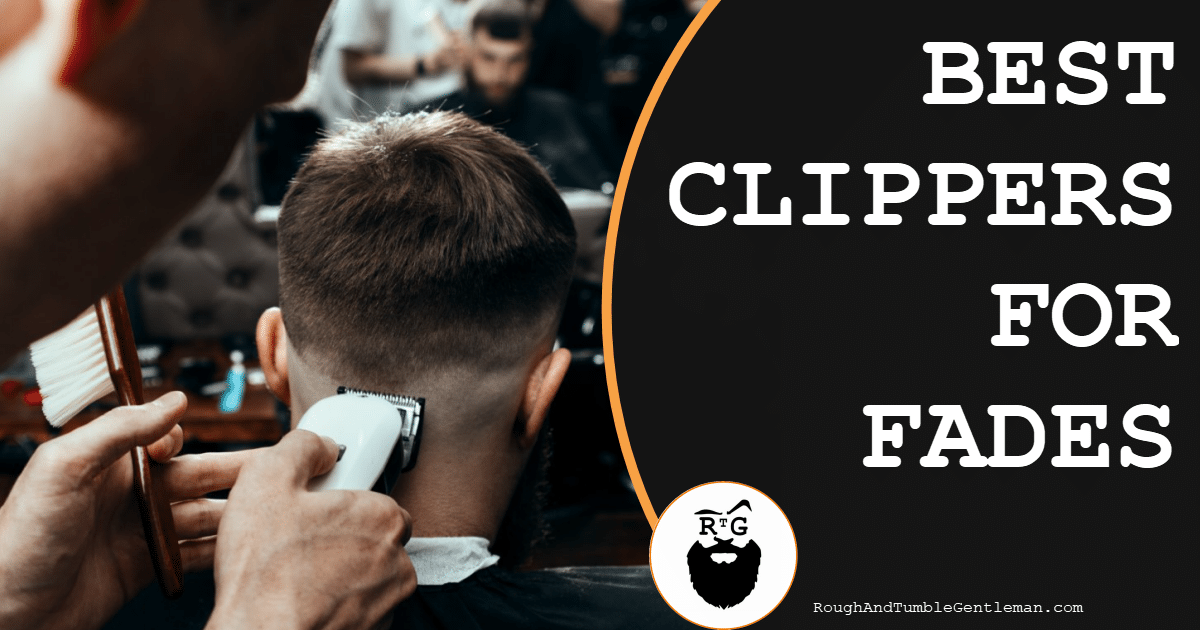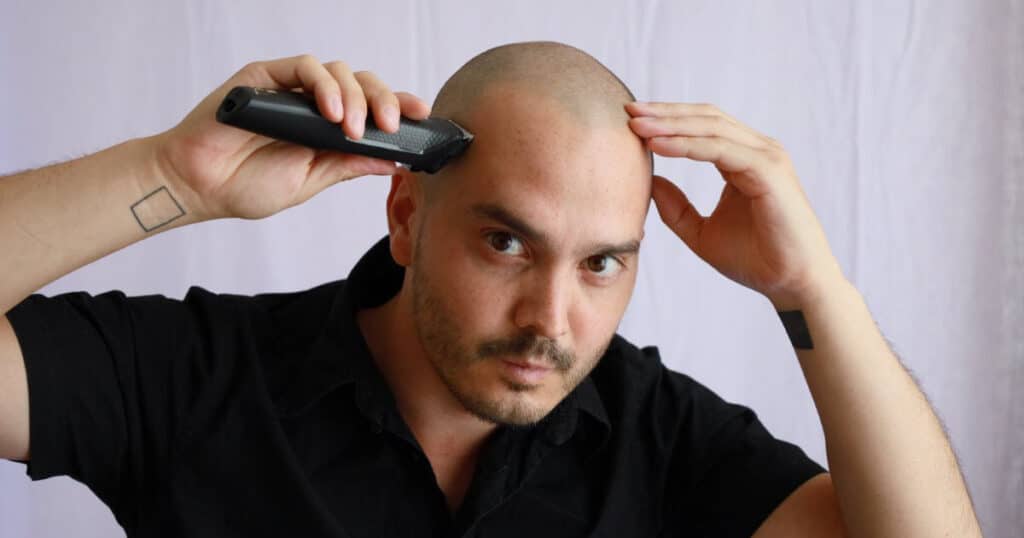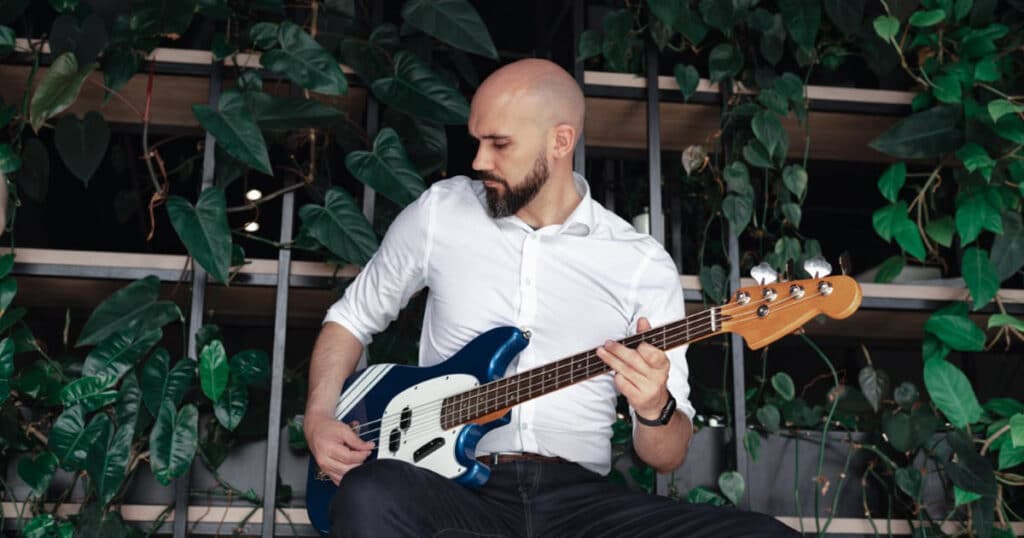We’ve been hearing that fades are having a comeback, and that’s odd, because we don’t think they ever really went anywhere. A well-cut fade is timeless, and if you look back on any era in history, you’ll see athletes, actors, and musicians sporting the fade. It never went anywhere, really. What does change, however, is the tools you use to get a fade. Clippers come and go, and some are great, and some are… well, some try their best. So today we’ll go over the best clippers for fades.
We’ll review each of our favorite clippers and discuss when it’s a good choice (and when it isn’t), and then we’ll go over all the other information you’ll need:
- how to select the right clippers for you,
- how to cut your own fade haircut,
- and how to care for your clippers so that they last for years.

Let’s dive right in.
Fade Clippers at a Glance
We’ll go into more detail below, but here’s a quick overview of our recommendations:
Best Overall, for Both Barbers and Home Use—The Wahl Professional 5-Star Magic Clip: Designed for corded OR cordless use, the Magic Clip can provide a gradient fade, and with its zero-gap blade, can provide a “complete” fade. It’s versatile and good for all types of cuts, and comes with a range of combs and accessories
Best Model Made Specifically for Fades—The Andis Professional Fade Master: If you want a tool designed solely to do fades, this is our suggestion—a professional-grade zero-gappable corded clipper built with a powerful motor that can cut extremely closely and create very tight fades when in the right hands. While it’s not as versatile as other models in our list, we think it’s an ideal fade-maker
Best for Beginners—The Wahl Clipper Fade Cut Haircutting Kit: This entry-level kit is designed with men’s haircuts in mind, and includes everything you need to do your own fade at home, including a corded clipper, combs, scissors, and more—it’s even got two tapered attachment clips to help you learn
Best Multi-Tool—The Philips Norelco Multigroom All-in-One: This sleek, multi-use, cordless clipper set is designed for at-home use even for those with limited experience. It’s built for beard and body grooming, but can also create a great fade, and can be a great option for guys who don’t want a ton of gear
Best Deluxe Clipper—BaBylissPRO Barberology MetalFX Series Clipper: This luxury clipper offers incredible performance, an impressive and unique metal design, and all the combs you need for a full haircut, and finally
Quietest Clipper—The Oster Fast Feed Adjustable Pivot Motor Clipper: A famously quiet clipper that gives professional results without exhausting anyone’s ears.
Gents, we are reader supported. If you click on a link we may shave a small commission at no additional cost to you.

Our Reviews of the Best Clippers for Fades
You want details? Good! Here’s an in-depth look at each of our picks, and what we like about them—and in few cases, what we find less-than-perfect about them, and whether or not that matters:
Best Overall: The Wahl Professional 5-Star Magic Clip


Wahl is one of the leading manufacturers of professional barber tools, and The Wahl Professional 5-Star Magic Clip gets our vote for best clipper for fades, both for professionals and for home use. It can provide a COMPLETE fade—and we’ll talk about a “complete” fade in a minute—and it can do pretty much everything else, from trims to full cuts to detail work. It’s a rare thing when a tool can do exactly what you want (which in this case, is fades) and do a whole bunch of other tasks, too.
We’re suckers for barber tools that have an old-school look to them, and the Magic Clip fits that bill—it’s got a broad, heavy build, with a recessed grip and rounded head. With that look, though, comes tried-and-true, reliable functionality: you can adjust the length at which the blade cuts with a manual lever, and that’s incredibly convenient—it allows you to graduate the level of fade in the hair without needing to replace combs, and that can be a huge time-saver. It makes things a lot easier, and gives you a lot of control.
And here’s the important thing: the lowest setting can already give a close shave, but you can adjust the blades to a “zero-gap” for a bare-skin shave. Earlier, when we mentioned a “complete” fade, that’s what we were talking about—a fade where the length of hair gets shorter, and shorter, and shorter, until it’s barely perceptible—and you can only get to the “barely perceptible” length with a zero-gap blade, which the Wahl Professional has. Keep in mind, you don’t need a zero-gap blade on a clipper, and you can get a great fade without it, but a high-end tool like the Wahl should have one.
We had mentioned earlier that the Wahl can also provide complete cuts. It comes with 8 comb attachments, so you’ll be able to use it to groom the longer hair on the top of your head, and that makes it very versatile—even if trimming and fading are its main purposes, it’s a surprisingly comfortable hair-cutting option.
There’s one other design feature that makes the Wahl 5-Star sticks out from its competitors: it’s got a corded / cordless design. That’s somewhat rare in high-end clippers—or any clippers, for that matter—and it gives you a lot of flexibility. You can skip buying batteries and plug it into a wall socket, or, if you appreciate your freedom of movement, you can load it with batteries and move about the space as you please. It can also save the day—if you need a quick cut but your batteries run out, it’s very nice to have the option to plug it in. Not all clippers have that feature.
The 5-Star clipper has a particularly fast running speed, thanks to a magnetic motor, and that speed contributes to its ability to provide a very close cut. It might heat up after you use it for a while (and that’s true for most clippers—even high-end ones), so that’s something to be mindful of.
All in all, this is a heavy-hitter, and our pick for best clipper for fades overall.
Best Clipper Specifically Made for Fades: The Andis Professional Fade Master


Andis is another manufacturer that has traditionally made products specifically for barbershops, but they, too, have started selling those products to a broader non-professional audience. The Andis Fade Master is made specifically for fades, and barbers far and wide—as well as non-barbers far and wide—use it for that specific task. It’s not as versatile as other fade clippers, but that’s by design: it’s meant do one task, and it do it very well. It can do so because…
It’s Got Thinner-Than-Average Blades. Super-thin blades are a clever design, because they allow an incredibly close cut, which is exactly what a fade requires. The thinner the blades, the closer to the skin you can cut. Of course, it’s also important that…
You Can Zero-Gap the Blades. As we’ve mentioned, a high-end model will allow you to zero-gap the blades, and the Andis provides that capability. Again, you don’t need to zero-gap the blades to create an excellent fade, but it sure does help. The Andis Professional also stands out because…
It Has Easily Adjustable Manual Length Setting. The lever is on the left-hand side of the model, allowing you to quick-change between lengths with your thumb. Lastly…
It’s Designed for Extended Use. There are a lot of clippers out there that are designed for once-a-day use, and once-a-day use that only lasts twenty minutes or so. Those models usually feel light and easy to maneuver, but they lack “heft”—they don’t really feel very powerful. And that’s fine—not all clippers are meant for round-after-round usage. The Andis Professional, however, weighs in at over a pound, and is designed for long-term, daily usage. If you’re a professional—or plan of doing a lot of fades—that can be an important feature.
As we mentioned, this is a specialty tool—it’s designed specifically for fades—so if you’re a barber, or if you like to re-establish your fade every few days, it can be a great tool. It’s not designed for general trims and haircuts, but Andis does sell combs you can attach to the blades if you want to cut longer lengths (the Andis Master Series Attachment Set). If you’re looking for a specialty tool, this is the one we’d recommend.
Best Entry-Level: Wahl Clipper Fade Cut Haircutting Kit


Wahl is generally known as a barbershop brand, but the Wahl Clipper Fade Cut Haircutting Kit is actually intended solely for at-home use. It comes as a huge bundle that includes all of the basics a person needs to cut his own fade at home, including—most importantly—a very solid clipper. We think it’s a great entry-level option, because…
It Comes with All the Essentials. There’s a lot you need to create a fade! The pros can do it with their eyes closed, but for the rest of us, it takes a lot of gear. The Wahl Clipper Kit features 10 on/off attachments clips to cut at different lengths, various combs and brushes, and a pair of scissors—all necessary to learn the ropes. And not only that, but…
That Gear is… Well, Geared Towards Beginners. The attachments are all “Secure-Snap” clips, meaning that they don’t wobble around on the clipper head when you’re using them. That happens to a lot of lesser-made clippers, and it’s the worst. The clips are also feature “right” or “left” combs, which allow you to cut the sides of the head into a perfect taper in one go. If you’re a life-long fade-cutter, you may consider that cheating, but it’s a GREAT way to learn.
It’s Got Maintenance Gear. We love this sort of thing, because everyone forgets that the key to keep a clipper working and usable is maintenance. The Wahl Clipper Fade Cut Haircutting Kit has blade oil, cleaning brushes, and a heavy-duty storage case. That’s most everything you’d need, and finally… oh yeah:
The Clipper Itself is Pretty Powerful. We’ve seen a lot of kits that are good for beginners, but the most important piece—the clipper itself—is garbage. The Wahl clipper—like all the rest of the Wahl line—has a history and reputation of well-made devices. And, if you get good enough, you can zero-gap the blades. Nice 🙂
The Adjustment Bar is Pronounced. On some beginner models, the manual adjustment bar is pretty slight—and that can be great if you’re using the model every day, all day. But for beginners, that larger-size bar is a great feature, because it makes it easy to use.
While it might not be as robust as Wahl’s more high-end clippers, most men cutting their hair at home really don’t need all that, making this a great option for guys who want to learn the ropes.
Best Multi-Purpose: Philips Norelco Multigroom All-in-One


There are many among who like to “travel light” thought this life, and if that’s your instinct, the Philips Multigroom All-in-One may be a good fit for you. It’s technically a beard and stubble trimmer that can also perform body grooming (beard, face, neck, and body), but it can also cut a mean fade. If you don’t like having a lot of tools around the house, or you hate buying tool after tool after tool, it can be a nice option, and it’s a great fit if you do most of your haircutting in the bathroom in front of the mirror.
There’s a lot to like here: it’s a full kit that features 5 blade/shaver implements, and two of the combs are cut at an angle, specifically so you can trim the sides of your/someone else’s head—you can taper your hairline in one go, without having to think about it too much. You’ll never see these kinds of combs in a professional set, but they can be a very convenient addition for someone with little experience trying to do their own fade. There are 14 guards that go from 1mm up to 16mm in length, and if 1mm isn’t close enough for you, it includes a small foil shaver attachment that may allow you to perfect your fade in a pinch.
One nice surprise is the design. Most “multi-groom” tools are a little clunky, but the Philips Multigroom is very modern, with a sleek stainless-steel body that feels sturdy but not heavy, and handsome black detailing. All-in-all, we’d say this is one of the more elegant options on our list. It has an ergonomic grip and a great angle for self-shaving, which are big bonuses for the at-home user.
Finally, we do like that it can be used both cordless and while plugged in, and there’s a 5-minute quick charge option that can be very handy—if it runs out of juice, you can plug it in and within five minutes, it’ll have enough pep for a trim. A full charge lasts for an impressive 5 hours of use, although keep in mind that the entire tool, in general, isn’t quite as powerful as some of the professional-grade options.
Keep in mind—this is not a traditional fade clipper, and if you’re a “fade purist” and looking for that “fade into nothing” look of a super-close fade, this won’t be able to do it for you. It can’t be adjusted for zero-gap cutting, and that’s why most fade purists want to see. But if you’re looking for a “regular” fade—that is, the gradient from very short hair to very very short hair that looks almost shaved—AND you want it to do a bunch of other stuff, like trim your beard and body hair, this can be a great option. We really like this one—we’ve given it as presents a few times.
Best Luxury: BaBylissPRO Barberology MetalFX Series Clipper


When push comes to shove, we’re a “form over function” bunch of guys. A thing can be pretty… but if it doesn’t work, it’s not worth it. “Function” has to come first.
Sometimes, though, there’s a marriage of “form” and “function” that results in a truly high-end, deluxe device, and the BaByliss Barberology MetalFX Series would be that device. It’s a luxury tool that’s designed to both perform and be an object of desire in-and-of itself, and… well, we’re big fans.
So let’s start with the “form” first—the look of it: it’s gorgeous! It’s sleek and streamlined and futuristic. It’s got a gently rounded handle covered in knurling
that makes it easy and comfortable to hold and definitely adds to the aesthetic (knurling is basically a designed forged into metal—in this case, it looks like diamond knurling, which feels fantastic to hold). It’s manufactured in four sexy colors—silver, rose gold, gold, and black—and if you didn’t know it was a clipper for fades, you might just think it was an object to be adored.
We like the way it looks, in other words. 🙂
But let’s talk function. The most important aspect of any clipper is the motor, and… can you guess who designed the motor on the BaByliss Barberology MetalFX Series?
If you guessed “Ferrari,” well… we don’t know why anyone would guess Ferrari, because it seems kind of random and magical, but you’d be correct. Ferrari designed the motor in the BaByliss Pro.
Why did Ferrari design the motor? We don’t know, but that’s pretty fantastic.
So chances are the motor is pretty decent. The other benefit of the BaByliss PRO—other than literally Ferrari designed the motor—is that the lever is much easier and more comfortable to adjust as you blend. With other clippers, you have to exert a little more force, but they switch is very easy on the BaByliss, and that’s a very nice touch. They’re also easier to zero-gap than many other blades, which is a real plus, because getting a zero-gap can sometimes be a trick. You’d imagine that getting a zero-gap on a model made by Ferrari would be difficult, because after all, Ferraris are gorgeous but reportedly more difficult to drive than “mere mortal” cars—so it’s a pleasant surprise that these are easy to gap.
As for extras, the BaByliss Pro features a lot of accessories, including 8 combs, a mini screwdriver for adjusting the blade, and a small tube of lubricant to keep the blades in good shape.
Plus, the battery on this baby can last for a full 2 hours of cordless use, and can also be used while charging. All good.
These are less “barbershop” and more “high-end salon.” They may not be a workhorse clipper for providing dozens of fades a day, and should perhaps instead be thought of as a finishing tool designed for specific use. If you want a tool that performs as a high-end clipper and has a bit of the old razzle-dazzle, these would be the clippers we suggest.
Best Quiet Clipper: OSTER Fast Feed Adjustable Pivot Motor Clipper


If you’ve ever watched a television show that featured a scene with someone in the 1950s or 60s using an electric razor or clipper—maybe Mad Men or something like that—you may have noticed that the clippers were LOUD. Like—really, really loud.
Older gentlemen love those models, and they worked pretty well and were very powerful, but they were wildly intrusive, and you would definitely wake up roommates / spouses / partners / housemates when using one.
Luckily, the good folks who make clippers have toned things down in recent years, and most clippers are waaaaaaaaaaaaaaaay more quiet than they used to be…
But sadly, they can still be pretty noisy. They’re nowhere as loud as they used to be, but many do make that strong BUZZ sound, and that can be irritating.
So if you’d like to avoid that, we’d suggest the OSTER Fast Feed Adjustable Pivot Motor Clipper. The clipper runs thanks to a pivot motor, which is a bit different than most clipper motors out there, and it runs quieter (and cooler, as well—it doesn’t get as hot as many other models out there). The pivot motor doesn’t get up to the same speed as the tools from Andis or Wahl, but it’s just as powerful and can provide a fade with the same elegance and grace as a stronger, louder motor. In fact, the lower speed can actually help prevent tugging in coarser hair types.
The clipper itself has a retro-style design, and Oster makes it a range of colors, which is neat—most clipper-makers don’t do that. At present, it’s manufactured in “Aqua Sky Tea Tree” (which looks like turquoise), a brushed aluminum, a maroon, a purple, and a “Soft Touch Blue” (which looks like a royal blue). That’s fantastic, because there’s not much variety out there when it comes clippers and their look (and their look is important!).
It’s not perfect, though—while it’s still very strong, it’s not quite as durable as some of the other clippers we’ve reviewed (but it is more lightweight and might be easier to hold for long periods of self-cutting)—and it’s a lot harder to adjust this clipper to the zero-gap setting, so we recommend it for those who want a reliable clipper but don’t necessarily need the tightest fade.
If you’re looking for a sturdy, effective, and relatively QUIET clipper for fades, this is the one we’d suggest—it can be a wonderful option for men with sensitive ears or easily-annoyed housemates.
Alright! There you have it—our picks for the best clippers for fades. We think there are some truly great options above, and it was a pleasure to review them.
If you’d like to learn more—like how to select clippers, and how to use them, and what some of the phrases above actually mean—well, read on, amigo:

Some Barbershop Terms You May Want to Know
We use a lot of terms throughout this article that can be a little confusing if you haven’t spent much time around barbershops. Here’s a quick glossary that should help you make sense of some of the haircutting lingo and clipper anatomy.
Fade: A fade is a type of hair outline where the hair becomes gradually shorter and shorter until it seamlessly blends into the hairless skin of the neck or temples.
Clippers: Clippers are a category of electric trimmers designed primarily for cutting head hair.
Combs/Guards: Guards are implements that extend the length at which a clipper cuts. They’re often called combs because they look a little like hair combs, and they help brush through and guide the hair into the blades.
Blades: The actual cutting implement at the tip of the clipper. Clipper blades have two parts, and they look a little like two rows of pointy teeth sitting one on top of the other. The lower row moves side to side, and is responsible for cutting the hair. The top is more of a guide, keeping the hair in place and guiding it into the lower blades.
Zero-Gap: Clippers usually cut hair down to 0.5 mm by default. Adjusting them to a zero-gap exposes more of the blade, and allows you to shave hair down even closer. When it comes to creating very tight, professional-looking fades, adjusting your clippers to zero-gap is a must.
Open/Closed Lever: On barbershop-style clippers, the lever adjusts the base cutting length of the blades (without combs). A closed lever (usually positioned upward) cuts closest while an open lever cuts the longest. There are usually a few halfway positions, as well.
How to Find the Best Clippers for Fading
When shopping for clippers for fades, there are a few factors to consider, from specific product features to your own personal needs.
Feature: Length Options
The most important feature in a pair of clippers for fading is the lengths at which the clippers can cut. Professional barbers often have a few sets of clippers set to different lengths for trimming different parts of the head.
If you’re in a similar situation, your priority should be to find clippers that can cut very close to the skin. Look for blades that can also be adjusted by just a few millimeters in order to create that gradual fade in the hair. For the tightest fade possible, make sure they can also be adjusted to a zero-gap.
At home, most men will want one set of clippers that they can use for a full haircut, so they’ll also need combs for their clippers. The combs allow you to cut hair down to a longer length. Most men will first cut their hair down to one even length all over, and follow it up with a more careful fade on the sides. If you’re keeping it simple, you may not want a bare skin fade at all and would be happy with the default lowest setting on your clippers.
Feature: Battery & Power
Before purchasing a set of clippers for fades, always make sure you know what to expect from the batteries or other power sources.
Corded use only. Clippers that can only work while plugged in are often more reliable, powerful, and long-lasting than their cordless counterparts. Corded clippers can last for decades, and you may just need to replace the blades every few years.
The added power and reliability, however, come with some drawbacks. You have to make sure you have an accessible plug when you want to use them, and you can get tangled up in the cords if you don’t pay attention.
If you’re the “buy it for life” type and you don’t mind watching out for a cord, we think a tool like this is the better choice.
Cordless. Nowadays, cordless clippers are the more popular option. They’re easier to use when doing self-cuts because there’s nothing for you to get tangled up in.
There are a few things to keep in mind before buying a cordless set of clippers, however. First, always take a look at the specs and check how long it’ll take for your clippers to reach full charge. Will you have to plug them in the night before? An hour before? And for how long will the battery last?
Corded and cordless use. If you’re the kind of guy who often forgets to plug in his electronics, you may want to look for clippers that can be used both cordless and while plugged in. These clippers are going to have the same battery-dependent longevity as ones that cannot be used while plugged in, but at least you’ll still be able to use them if you forget to charge them.
Feature: Noise
No one likes loud noises, but for men doing their fades at home, it might be an extra important factor to consider.
Noise largely depends on the kind of motor that powers your clipper. Pivot motors, like on the Oster, tend to keep fairly quiet, although we find the magnetic motor on the Wahl 5-Star isn’t bad either.
Feature: Ergonomics
Your hands can get tired pretty quickly when you’re doing your own fade, so weight and ergonomics are worth considering. It’ll be easier to hold a light clipper if you tend to spend a lot of time styling and fixing your hair.
However, if you’d rather prioritize durability and power, you may need a tool with a more robust casing or a larger motor.
Feature: Versatility and Add-Ons
There are three main levels of usage that a set of clippers can provide, based on the clipper design itself as well as the accessories:
Fade-Focus. In general, the best fade clippers are designed primarily and almost singularly for creating fades. They have extra-thin blades that cut closer to the skin, and just enough adjustability in order to shave the sides of the head in a graduated style.
This is what professionals usually prefer since they want the best tool for every job. For those who are already cutting their own hair at home, a clipper dedicated to fading can be a nice addition to your toolset.
General Haircutting. Most clippers are designed for cutting hair in general, but they can also fade. These clippers might have a slightly more steeply angled blade, which correlates with a slightly less close shave. However, they can sometimes still be adjusted to a zero-gap, which largely addresses that issue.
In general, these kits are better for most at-home users, since they come with the longer combs necessary to do a full short haircut with a fade. Depending on the kit, you might not be able to create the same extreme nude-to-stubble fade, but it’s more than enough for a more conservative fade.
All-Over Trimmers. In general, all-over trimmers that can be used on the face, head, and body are rarely the best tool for creating a fade. However, if you don’t need to cut your own or other people’s hair often, a versatile beard trimmer can occasionally work for creating fades.
The main benefit of an all-in-one trimmer is that it’s also incredibly useful as a face shaver and body trimmer. The other benefit is that it’s quite common to shave the beard down very closely, so these kinds of trimmers can often do a better job of detail work and very extreme fades than general haircutting clippers, even if they don’t excel at cutting the rest of the hair.
Feature: Style
There are a lot of great clippers for fades on the market, so you’re allowed to make your final decision based on style. Some men love the industrial vibe that most Andis machines have, while others prefer the retro vibes of a Wahl or BaByliss.

How to Cut Fades with Clippers
Once you’re the proud owner of a quality clipper, you’ll probably want to learn each of the steps on how to go about creating a fade.
This method is a slightly easier variation on how professional barbers usually create fades. It’s a little like carving out stairs into a mountain but in reverse.
Don’t start doing this an hour before you have to rush to work or on a hot date—a good fade shouldn’t be rushed, especially not your first time. Give yourself at least a couple of hours to fade your hair.
Wash your hair. It’s nicer to cut hair when it’s clean and freshly washed. The water from a warm shower will also help to soften your hair and make it more pliant, which will make cutting and fading a little easier.
Prepare your setup. Before you start doing anything, gather all of your equipment, first. You’re going to need to make sure your clippers have enough charge, and you may also want some towels or a robe.
Finally, you’ll definitely need a multi-mirror setup so you can look at your hair from behind. A handheld mirror can work in a pinch, but if you’re planning to self-cut your hair often, finding a way to mount two mirrors so they face each other will give you a lot of visibility. Alternatively, you can purchase a dedicated self-haircutting mirror you can bring in a roommate or significant other to help you out.
Cut all over. If you’re giving yourself a full haircut, start by dealing with the bulk of hair on top and sides of your head. That can mean trimming a little from the top or setting your clippers to one of their longer lengths (probably with a comb) so you can cut all over evenly.
Whatever you decide to do, it’s useful to have an action plan, but also, don’t be too ambitious.
Start the outline. Once you’re happy with your maximum length you can start outlining. Use the shortest setting on your clipper, and move the blade from the bottom up, going against the direction of hair growth, to mark out the area where your outline should start. Move the blade sideways to carve out the outline, and then move it from below to clean away any hair that grows below the outline.
Gradually go longer. Once you’re mostly happy with your outline, adjust the length of your clipper to the next higher setting, and create another border of slightly longer hair above your outline.
Blend as you go. Set your clipper back down to the previous length, and with short upward strokes carefully blend the connecting lines. Some men prefer to do the blending all at once, after they’ve finished cutting these “stripes” into their hair.
Move on up. Set your clipper to the next length up, and create the next “stripe” of your fade. Once again, blend it by going down a size.
Repeat. From here on out, you’ll just need to progressively increase the cutting length of your clipper while working your way up the sides and back of your head. At some point, you may have to pop comb guards over your clipper.
Blend into the top. Finally, with your clippers or with scissors, you may have to blend your sides into the top of your head. Each hairstyle is a little different, so how you actually go about this depends on your overall look.
Refine the fade. Finally, you have a chance to make small corrections and adjustments to make sure your fade is as seamless as possible. Scan your head for areas where the difference in hair length is too abrupt, and blend those some more.
In a barbershop, a professional barber will often finish off a fade with a foil shaver or even a straight razor. Even a zero-gapped clipper can leave behind a bit of stubble, so they’ll do a proper shave to make a very intense gradient. You can do that, too, if that’s the kind of fade you’re into.
A note on other fading methods: Some men like to follow this process in reverse. Instead of starting with the shortest part of the fade, they start by trimming all over with the larger combs, and then they progressively trim lower and lower with shorter combs or clipper settings.
This method can work well if you’re nervous about starting out with your clippers set to their shortest setting, and it can create a nice conservative fade. However, it also forces you to repeatedly trim the same areas, so the entire haircut can take a lot longer.
Zero-Gapping Your Clipper
We’ve talked about zero-gapping a lot so far, but how can you actually set your clippers to zero-gap? Should you even do it? This section will help you decide.
Why Set Your Clippers to Zero-Gap?
By default, the closest shave most clippers provide is around 0.5 mm, unless they’re advertised as “balding.”
Clipper blades have two parts—the sharp lower half that moves side to side to cut the hair, and the upper half that acts as a guide. By adjusting them so that they line up right against each other, you can significantly reduce the cutting length. That’s what we mean by zero-gapping.
For the average person using clippers, the default length is as close as necessary. You can create a more classic, subtle fade without adjusting your clippers. If that’s all you want, don’t worry about zero-gapping.
However, when it comes to today’s dramatic fades, clippers or outliner trimmers set to a zero-gap are basically a must. If that’s what you’re aiming for, make sure to learn how to do this adjustment yourself.
When you set your clippers to give what’s basically a bald shave, you increase the risk that they’ll irritate or cut your skin (and that’s why there are balding clippers dedicated solely to bald-head shaving). This is why, even if you do want to progress to eventually fading with zero-gapped clippers, it’s best that you first use your clippers a few times without adjusting them.
How to Zero-Gap Your Clippers
If you feel ready to set your clippers to a zero-gap, this is how you do it.
What you’ll need. In addition to your clipper, you’ll also need a screwdriver. Make sure that your clippers are adjusted to their lowest setting (i.e. a closed lever).
Get loose. There’s a pair of screws that connects the blade to the body of the clippers. Use the screwdriver to loosen them up a little, but not completely. You want to be able to adjust the top part of the blades without fully taking them off the clipper body.
Adjust. Gently pull the upper half of the blade downwards, so the tips align a little more closely with the lower blades. Err on the side of having the upper blades still extend a little further out than the lower ones. Be careful as you do this, and make sure that the blades line up straight from side to side. If you try to cut hair with the upper blades on an angle, you can accidentally injure yourself.
Tighten. Once your blades are set the way you want them, you can now tighten up the screws. Do this slowly and carefully, so that your blades don’t suddenly become misaligned while you tighten. We recommend holding the blades in place while you tighten, going back and forth between the screws to ensure that you tighten everything evenly.
Check. Once your blades are tightly screwed in place, examine them closely one more time to make sure everything is aligned. If it isn’t, you may need to loosen the screws a little to make adjustments. If all is well, it’s worth doing a few test cuts on your arm to make sure everything is also working as it should.
How to Care for Your Clippers
Even the best clippers for fades will act up or malfunction if you don’t take great care of them. Here’s what you can do to make sure they keep working beautifully for as long as possible.
Keep them oiled. Blade oil or clipper oil acts as a lubricant, to prevent friction and keep your blades sharp, and it’ll also repel water to prevent oxidation and rusting. Just a small drop is enough—if you’ve applied too much, you can wipe off the excess with a paper towel.
You’ll probably want to do it either before or after every serious use (i.e. after creating a full fade). If you’re just doing a quick touch-up, you probably won’t have to oil your blades again. Professional barbers will often oil their blades on a daily basis, since they use their clippers so heavily.
Clean them regularly. Keeping your clippers clean is another way to ensure longevity. Professional barbers should sanitize their clippers with alcohol or dedicated sanitizing spray.
At home, regularly brush away any bristles trapped in the blades, and do a more thorough clean with alcohol or spray after every few uses. If you’re using trimmers like the Philips Bodygroom, rinsing with soap and water may work.
Keep them dry. Most clippers for fades are not water-resistant, so keeping them dry is an important part of ensuring great functionality. Don’t rinse them, and make sure to store them somewhere safe and dry.
Charging correctly. If you decide on cordless clippers, pay attention to how you charge them. Both letting your clippers sit with an empty battery or leaving them plugged in for too long can damage the battery. Always follow the manufacturer’s advice on how to charge your clippers correctly.
Avoid dropping them. Clippers are complicated pieces of machinery, and the blades themselves are very delicate. Be careful when handling your clippers and avoid dropping them, since damage to the blades can lead to injuries.
Replace parts as needed. If you take great care of the body of your clippers, you can get years and years of use out of them! If the blades eventually stop cutting well, despite regular cleaning or oiling, the good news is that you can buy replacement blades for many models (especially from pro brands like Andis, Wahl, and Oster).
Get Faded
It looks like you’re about to enter the world of fades! Whether you’re planning to use clippers to do your own fades, help out your friends and family, or work as a professional barber, a quality pair of clippers for fades makes all the difference. Have fun, be good, and happy clipping!
Michael Morris is the head writer here at Rough and Tumble Gentleman. He's got a ducktail beard and loves Brazilian jiu-jitsu. He's married to the woman of his dreams and lives in Brooklyn, NY.




